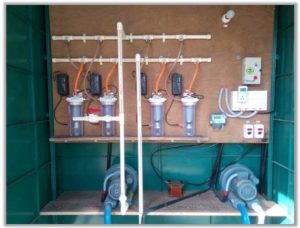New Wastewater Recycling System Developed
India is among the world’s most water-stressed countries, today. Per capita water available is set to decline to 1465 cubic meters by 2025 from 1544 cubic meters in 2011, according  to a 2018 Niti Aayog study. With the country hurtling towards a water crisis, we may soon have to confront a whole bunch of associated problems, ranging from health issues due to poor sanitation, and conflicts over water access, to food security and climate change. Recycling and reuse of treated wastewater could be one of the measures to reduce the pressure on water resources.
to a 2018 Niti Aayog study. With the country hurtling towards a water crisis, we may soon have to confront a whole bunch of associated problems, ranging from health issues due to poor sanitation, and conflicts over water access, to food security and climate change. Recycling and reuse of treated wastewater could be one of the measures to reduce the pressure on water resources.
Researchers at the Centre for Sustainable Technologies (CST), Indian Institute of Science (IISc), have developed a decentralised wastewater treatment and recycling system at a primary school, situated in the remote village of Berambadiin Karnataka, which has helped save 180,000 litres of water in a year. The system has, over the past year, enabled the reuse of wastewater and reduced dependence on freshwater resources. The study has been carried out in collaboration with researchers in the UK.
According to the IISC press release, the research team operated the greywater treatment system for a year and monitored the different physicochemical and biological characteristics of the greywater at the entry and exit points. The performance of every treatment stage was quantified in terms of removal efficiencies (REs) of turbidity, Total Suspended Solids (TSS), nitrate, total phosphorus, Biological Oxygen Demand (BOD), Chemical Oxygen Demand (COD) and faecal coliforms (FC). Overall, the system showed high REs – more than 90% for most of the parameters. The system treated 667 litres of greywater daily, saving around 180,000 litres of water annually.
Also Read : A Year after Jal Shakti: A Paradigm Shift in Water Policy?
“We have demonstrated for the first time that decentralised wastewater treatment systems can be economically put into practice in a rural setting” says Lakshminarayana Rao, Assistant Professor at CST, and a senior author of the paper published in the ‘Journal of Water Process Engineering’.
The treatment system first passes the greywater from the hand wash sinks through strainers that screen out large food particles from water. “Then, the water goes through three anaerobic sand bio-filters – tanks filled with locally available coarse gravel, medium gravel and sand, where bacterial biofilms help in the breakdown of nutrients in greywater to reduce nutrient levels of water,” explains PS Ganesh Subramanian, a former Project Assistant at CST and the first author of the paper.
The greywater from the kitchen sinks is first passed through a grease trap to strip off the top layer of oil and grease from water. After this, water flows through an anaerobic sludge bioreactor followed by a stratified biofiltration chamber. Finally, the filtered water from both hand wash sinks and kitchen sinks is passed through aeration and ozonation tanks, where it is treated with ozone for disinfection. The treated water stored in an overhead tank is then readily available for reuse by the students and staff of the school for domestic non-potable purposes such as toilet flushing and gardening.“Ozonation removes odours and colours from water, and eliminates FC, thereby disinfecting the water while leaving no harmful by-products. [It also] enhances the Dissolved Oxygen (DO) concentration of the water,” explains PS Ganesh Subramanian, a former Project Assistant at CST and the first author of the paper.
India will need 1.5 trillion cubic metres water by 2030, according to the Central Pollution Control Board. Where would India get water from in the coming years? The decentralised wastewater treatment systems may be holding one of the keys to the answer.
“The people from Berambadi village are very happy with the system. Based on the success of this sustainable wastewater management project, several other schools in Karnataka have approached us to duplicate it in their schools,” divulges Lakshminarayana Rao.
